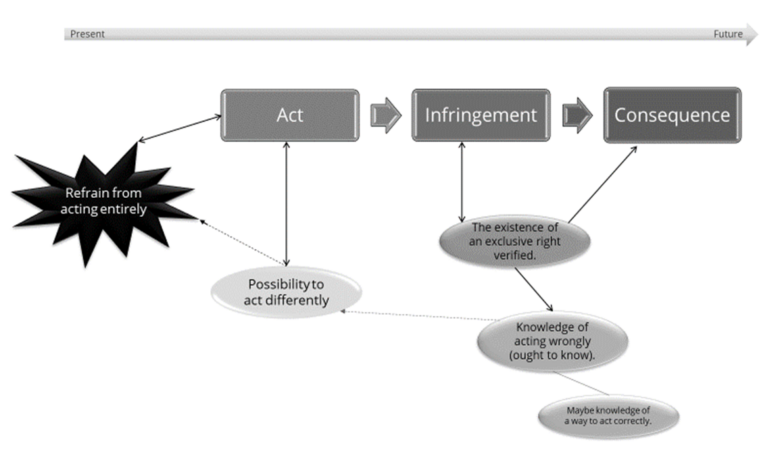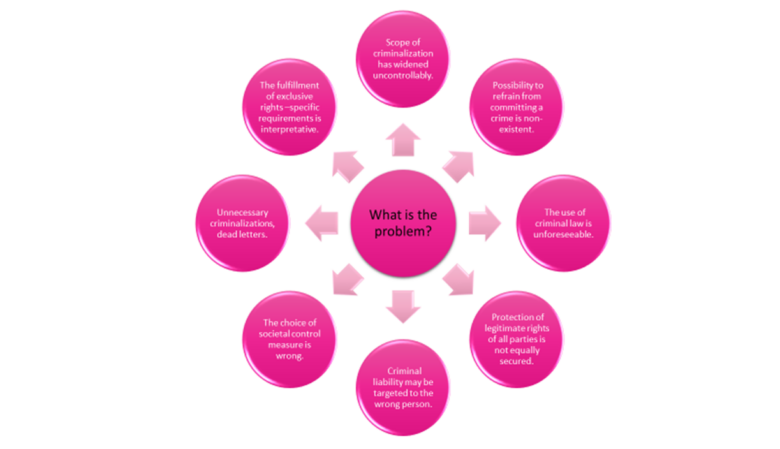Justified Criminalization of IPR Infringements – Focus on Copyright and Trademarks

Academic Dissertation by Laura Tammenlehto was defended on 28 April 2023.
The dissertation studies criminal enforcement of intellectual property rights (IPRs) in the Nordic countries (that is, Finland, Sweden, Norway, and Denmark). It assesses the legitimacy and justness of copyright and trademark crime provisions, and the tension they create within the existing criminal justice system due to the abstract nature of the interests being protected. The research concentrates on analyzing the chosen provisions in the light of the requirements set for the use of criminalization and justification of punishments.
This research operates in the interface of two very different fields of law and touches on a third one. First, it operates in the field of criminal law, which is the most strictly regulated field of public law, and which may be used only to seek the common good and ensure a peaceful society. Second, it positions in intellectual property law, a branch law at the furthermost end of the civil law regime, in which the rights of a private person are accentuated and the positioning of one’s own interest before anyone else’s is common. Finally, the research touches on the field of procedural law, analyzing the objectives of both civil and criminal procedure with respect to enforcement of copyright and trademarks, and suggests guidelines to the choice of sanction. The focus of the research, however, is on criminal law and criminal procedure.
The ideologies and purposes of the aforementioned two fields of law, that is criminal law and intellectual property law, (and hence the civil and criminal protection of IPRs), are very different, which causes legal conflicts in the field. The purpose of intellectual property law is to promote creative activity by means of incentives and to promote technical development in society. Authors are granted the exclusive right to financially utilize their intellectual creation, in which they have often invested both financial and intellectual capital. The protection of intellectual property and IPRs target products of creative mental activity in the fields of science, industry, literature and art.
At the same time, the use of criminal law and the criminal justice system requires an acceptable purpose. The targets of protection must be defined precisely, and there must be certain grounds for using criminalization instead of some other form of social control. These grounds can be specified in the form of criminalization principles, which limit the use and content of criminal law.
This research approaches the topic through two research questions. First, the research studies, how should the existing criminal law system meet the challenges posed by the abstractness of the objects of protection, the growth of technical developments and the advent of digitalization. Second, the research analyzes how should the requirements set for the use of criminalization and justification of punishments be acknowledged in drawing the line between criminal enforcement and civil enforcement of IPRs. The research compares the Nordic countries’ criminal legislations and criminalization of IPR infringements. It assesses IPR enforcement regulation in relation to the doctrines of the criminal justice system using legal dogmatics method and a twofold analysis: first, the regulation is analyzed through the creation of an assessment framework that consists of criminalization principles and penal theories – i.e. the grounds that justify the use of criminal law. Second, the study analyses the conformity of IPR enforcement provisions and their application in case law in relation to this framework. The research utilizes the created framework to conceptualize the dividing line between IP law and criminal law or, more precisely, the interface between the legitimate and justified use of civil and criminal measures.
***
To be able to dive deeper into the problems found in the interface of the two analyzed fields of law, the dissertation briefly visits the general starting points behind the use of punishments in the Nordic countries, that is, the Nordic criminal policy. The Nordic countries treat criminality as a social problem. The main goals of the Nordic countries’ criminal policies are (a) minimizing the suffering and other costs caused by criminality and the control of it, and (b) dividing these costs justly between the members of the society. The criminal justice system is seen as a tool by which to maintain respect for important social values, while emphasizing its role as the last resort in reacting to breaches of societal order.
In distinction to the goals of the EU legislation and many international treaties, Nordic criminal policy is built on the concept of general prevention. General prevention means the effect of the criminal justice system on members of society, that is, the general societal impact of a punishment. It comprises several different elements through which the preventive effect of a punishment is achieved. The criminal justice system’s ability to affect people’s attitudes, values and behavioural models, through which they accept the legitimacy of the criminal legislation and follow its rules is key to this. The functionality of the criminal justice system does not lean on fear of punishment – that is deterrence – but on acceptance of and respect for the system, and the perception that it is fair and worthy of being followed. Hence, the conception of general prevention in the Nordic countries differs from general deterrence, for deterrence is merely one element through which general prevention is seen to operate. The Nordic approach does not require a severe penal system, but utilizes socio-ethical disapproval, which affects one’s sense of morality and justice. The legitimacy of the entire criminal justice system, which increases the importance of the principles of equality and proportionality, is a key aim in this regard. To achieve an adequate general preventive effect, the dividing line between acceptable and unacceptable behaviour should be clear.
***
Intellectual property is generally understood as intangible property that depicts or is a product of the creator’s original ideas. Intellectual property law protects these depictions and products by assigning and enforcing legal rights, i.e., intellectual property rights, in respect of them. Typically, intellectual property rights surround the control of physical manifestations or expressions of those ideas. The object of protection under IPRs must be separated from its embodiment. What IPRs protect is the intellectual creation of the author, not the specific physical embodiment of that intellectual creation. For instance, spontaneous music or other performances or speeches may fall under the scope of protection of copyright even if they are not recorded in any way. However, there are forms of protection that cover purely intangible elements, such as moral rights in copyright.
Since the formation of exclusive rights creates a foundation for the use of the enforcement system it is important to conceptualize how the protection of the exclusive rights under copyright and trademark are formed: if no exclusive right exists, there is no need to enforce any right, nor can there be a violation of that right.
The Nordic laws state that protection for trademarks may be acquired through a statutory registration process, or by establishing trademark through use. Registration provides unambiguous evidence as to whether a trademark exists or not, although an unregistered mark may become protected through use. However, establishing trademark through use requires that the mark becomes generally known in trade as a distinctive mark for its user’s products or services. The Nordic laws remain silent on the procedure through which trademark protection can be established through use and the exact moment at which trademark protection is established through use. In other words, the Nordic laws do not specify how trademark protection is established through use, nor do they specify when it is established through use. Both elements are to be defined case-specifically and retrospectively by a court to clarify the existence of an exclusive right, which causes uncertainty of the existence of an exclusive right and the violation of it thereof.
In the field of copyright, fulfilment of the exclusive right-specific requirements means that a piece of work must exceed the (copyrighted) work threshold (or teoskynnys in Finnish). The starting point for evaluating the fulfilment of the work threshold is that the protected work is an independent and original result of the author’s creative work. As mentioned earlier, the Nordic copyright laws protect the form of expression of a work and how it exhibits the author’s personal creativity, not the actual piece of work itself. The fulfilment of the work threshold may vary between different types of work and is defined case-specifically and retrospectively by a court. A key difficulty regarding the assessment of the fulfilment of the work threshold is that it cannot be said with certainty that the work threshold is exceeded even regarding all known forms of work, let alone the forms that are yet to be developed, for it is always defined retrospectively by a court and the assessment requires the originality and independence interpretation. Similarly, as was the case regarding trademarks, this causes uncertainty of the existence of an exclusive right and the violation of it thereof.
***
Regarding criminalizing unwanted behaviour, there are four different criminalization principles that should be fulfilled. First, is the principle of legality, which consists of four elements: the requirement of written (criminal) legislation, the prohibition of analogy, the prohibition of retroactivity, and the prohibition of vagueness. The principle of legality legitimizes criminal legislation by tying it to law enacted by parliament and separates powers by establishing parliament as the sole legislator. It ensures legal certainty, and the foreseeability of the application of criminal law is of paramount importance.
Second, criminalization must always have a justified object of protection, which is to say that it should always be designed to safeguard some legitimate protected interest. Criminalization should be used only in situations where it can be expected to impact upon the occurrence of the criminalized behaviour. Justified objects of protection may be loosely defined as interests that are societally important and that at least in most cases are tied to basic and human rights. In other words, there must always be an interest that is protected by criminalization and a strong societal need to protect that interest. These interests often relate to moral values, although the criminalization of pure violations of morality is impermissible.
Third, the principle of social cost evaluation states that the societal advantages gained by means of the utilization of criminalization must outweigh the disadvantages caused to both society and to the perpetrator. The idea is that society’s resources should be targeted reasonably, and the control system used should be chosen expediently. Furthermore, the costs caused by criminality should be divided fairly between society and its members. The principle of social cost evaluation prohibits the use of criminalization if its societal impacts are mainly harmful, even if there is a justified object of protection to safeguard, and there is no other way to effectively protect it.
And fourth, the ultima ratio principle states that criminalization should only be used as a last resort in interfering in individuals’ lives. Whereas the requirement of justified object of protection outlined above is to the effect that criminalization must be used to protect some societally important interest, the ultima ratio principle stipulates that criminalization is acceptable only if the desired protection cannot be achieved by any other means of societal control that restricts basic and human rights to a lesser degree, such as, for example, civil remedies. In other words, the criminal justice system should be used to protect a societally important interest only if other morally more acceptable systems fail to achieve an equitable effect at reasonable cost. Criminalization should not be resorted to just to be on the safe side but is reserved for the most socially reprehensible violations.
***
Although the comprehensive analysis of the grounds for criminal liability per se is limited out of the dissertation, analysing the defendant’s possibilities to refrain from breaking the law is vital. The starting point is that a person cannot be held criminally liable for behaviour he or she could not have avoided, even if the behaviour in question fulfils the essential elements of a crime. In other words, a person cannot be held criminally liable if he or she was unable to act in accordance with the law. The possibility to act differently is twofold: first, it requires that an average diligent person could have acted differently to the way in which the defendant acted in the situation at hand. Second, it means that the defendant has not sought to prevent the consequences of his or her acts with all his or her actual capacity. These elements are not unconditionally separable from each other, but somewhat overlap.
As pointed out earlier, regarding IPR crimes, it may often be unclear whether an exclusive right, and, therefore, an infringement exists in the first place, in which circumstance it is not easy to recognize the need to modify one’s behaviour. Therefore, one might ask if there is a possibility to act differently at all. This shows rather well the problems the inaccuracy of the objects of protection and the criminalization regarding their violations create in the studied field. These problems can be illustrated with the following figure:

***
Through the analysis of the previously described legal concepts and phenomena, with more specific examples of the contradictions between them, the dissertation comes to the following key findings. First, the dissertation shows that the Nordic criminalizations regarding copyright and trademark infringements have expanded uncontrollably due to digitalization and other technical developments. The Nordic copyright and trademark laws are very multi-layered and complex, which complicates the interpretation of the crime provisions related to them. This makes it very difficult, if not impossible in some situations, to identify, based purely on the criminal provisions or even on the entire special law, which type of behaviour is punishable and how severely. As a result, criminal law becomes unforeseeable.
Second, the dissertation shows that Nordic copyright and trademark infringement criminalizations could and should better fulfil the requirements of the criminalization principles. The descriptions of criminal acts contained in the relevant legislation are vague and employ an overly complicated criminalization technique combined with inaccurate definitions of the objects of protection and key concepts. This makes it extremely difficult to define the limits of punishable behaviour based on the legislation. The uncertainty of the existence of exclusive rights in general, as well as potential lack of knowledge of the author’s personality hinder the perpetrator’s possibilities to act differently to avoid criminal liability. These factors increase the unpredictability of criminal law and the unjustness of criminal liability as a form of liability in this area.
Third, as a large part of the regulation in force in the Nordic countries comes from the EU and from international conventions, which pursue different goals than those pursued under Nordic criminal policy. Regulation emphasizing deterrence has been adapted as such in a system that does not pursue mere deterrence but general prevention. This results in the use of law becoming unforeseeable and the law ultimately failing to protect the parties’ legitimate interests, in this case particularly those of the defendant. The IPR enforcement system has shown indications of slipping into pursuing incorrect goals with incorrect measures, which reflects that neither the goals of the IPR system nor those of criminal policy are met. The key findings can be illustrated with the following figure:

***
As a solution to the recognized problems the research suggests the following: first, the Nordic copyright and trademark crime provisions should be rephrased and simplified in such a way that specific actions may be more accurately defined based on them. This could be achieved either by narrowing the currently open-ended approach to criminal liability to cover only the known behaviour and known objects of protection and elaborating the existing descriptions of acts. Both measures would require the inclusion of more accurate definitions of necessary legal concepts in the legislation, however, they would increase the foreseeability of criminal law in the field.
Second, the dissertation suggests that instead of maintaining a system of criminalization of IPR infringements that expands uncontrollably, the Nordic countries should consider a wider application of the ultima ratio principle. Certain threats to for instance economy and health and safety should addressed in part by existing criminal liability in other legal areas, for example, fraud or defamation provisions. The dissertation proposes reconsideration of the scope of criminalization of both copyright and trademark infringement as well as a move towards more accurate and more narrowly drawn criminal law provisions targeting aggravated and intentional acts done with commercial purposes in mind, as well as decriminalization. Especially regarding moral rights infringement, the dissertation calls for more thorough examination of other suitable means under the sanctioning system, before choosing to criminalize behaviour that is practically non-existent, as well as suggests more effective use of other existing criminal provisions instead of criminalizing pure moral rights infringements separately.
Third, the dissertation suggests that, in the future, the focus of application should be shifted more towards civil remedies. Civil remedies are an adequate tool by which to ensure the payment of fair compensation for the right-holder and stop the infringing activity. Civil measures are designed to meet the needs of the right-holder and include an element of coercion—the defendant must, for instance, pay damages. Criminal measures are designed to ensure social tranquillity and serve the purposes of the entire society. More effective use of the civil enforcement system would support the idea of preserving criminal sanctions for the most severe situations, in which there are specific grounds for criminal liability – i.e., as ultima ratio. The suggested solutions can be illustrated with the following figure:





